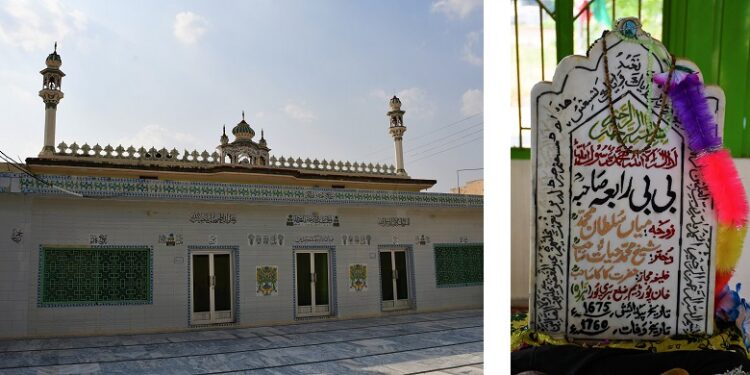
The local community visits the shrines on a number of occasions to seek the blessing of the female saint of Budhial.
Zulfiqar Ali Kalhoro
Budhial is a historical village in Talagang tehsil. It is located about 20 km from Talgang town on the Talagang-Tamman road. I visited the historical Budhial village with historian and writer Tariq Mehmood Malik. According to Malik Muhammad Ghaus, the author of Tarikh-e- Budhial, the village was founded by Budha Khan in the first quarter of the 16th century and was located on Kiran Wali Dheri on the northern side of Ankar Nala. Budha Khan belonged to the Rehan lineage of the Awan tribe. Later the grandsons of Budha Khan – Agar Khan, Amant Khan, Fateh Khan and Bamli Khan – moved from Kiran Wali Dheri to found the present Budhial village. The descendants of Budha Khan are known as Budhial and are divided into different lineages: Agral, who trace their ancestry from Agar Khan; Mantal, who are descendants of Amant Khan; Phatial, who trace their ancestry from Fateh Khan; and Bamlial, the descendants of Bamli Khan. Bamlials are further divided into two main lineages: Salhal who trace their ancestry from Muhammad Saleh and Mial the descendants of Mian Inayat son of Mian Muhammad Aqil who was the grandson of Bamli Khan.
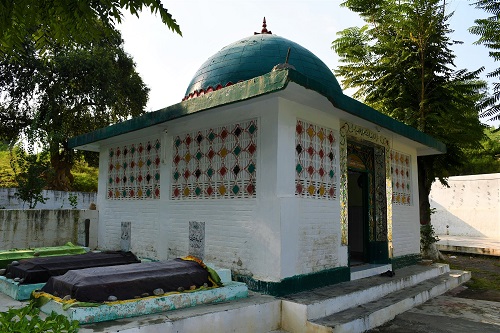
Baba Mian Muhammad Hayat son of Babar Khan was a famous mystic of Budhial village from the family of Bamilals. He was known for his piety and left his village in search of his spiritual mentor. He obtained religious education in Ghebi (Pindigheb) and Khatri in Fateh Jang. According to Abid Minhas, the author of Tazkira Aulia-e-Chakwal, Baba Muhammad Hayat was a deputy of Kasteer Gul Rahamkar alias Kaka Sahib whose shrine is located at Ziarat Kaka Sahib in Nowshera district in KP. He was a Suhrawardi Sufi and some believe that he was an Awaisi Sufi.
After getting the robe of initiation from Rahamkar alias Kaka Sahib, Mian Muhammad Hayat settled in Shohal in Hazara and was known as Shohalan Wali Sarkar. After some time, his brother Mian Muhammad Aqil Awan also came searching for his brother in Shohal village. He was also known for his piety. It was there where he started preaching the thought and ideology of his spiritual mentor Kaka Sahib. Soon Shohal village became centre of his missionary activities and he also became known as the Pir of Shohal.
Hamdam Kami, the author of Ahwal-e-Talagang, believes that Baba Mian Muhammad Hayat lived during the reign of the Mughal emperor Aurangzeb. Mian Muhammad Hayat died in 1708 and was buried in Shohal. Many people became his disciples and deputies. Some of his eminent deputies include his daughter Bibi Rabia, Mian Sharafuddin, Baba Mian Aqil, Baba Noor Khan and Saidullah Khan Tehmim Chinioti.
I visited the shrine of Mian Muhammad Hayat with Hamdam Kami, an eminent writer and historian of Talagang, who now lives in Taxila. The shrine is located in Shohal village in Khanpur tehsil in Haripur district. In fact, the shrine is situated nearby the spillway of Khanpur Dam. There are two graves inside the tomb which belong to Mian Muhammad Hayat and his brother Mian Muhammad Aqil. Three graves are located south of the tomb on a common platform which belongs to Mian Rehmatuddin, Mian Fazaluddin and Mian Abdul Karim respectively. Baba Muhammad Hayat is known as Mian Sahib in Hasan Abdal and Taxila tehsils. It is the most popular shrine in the area. The local community visits the shrine on different occasions to pay homage to the saint.
Baba Mian Muhammad Hayat had two sons and a daughter. He transferred his spiritual succession to his daughter Bibi Rabia. She was born in Shohal village in 1675. According to Tarikh-e-Budhial, she was married to Mian Sultan Muhammad, who was the son of Mian Inayat and grandson of Mian Muhammad Aqil in Budhial village. She was a pious lady and continued the spiritual legacy of her father. After her marriage, she moved from Shohal village to her ancestral village Budhial where she started preaching. There are a few female shrines in Talagang and Lawa tehsils, but the shrine of Bibi Rabia is the most popular in Talagang tehsil. The shrines played an important role in the socio-religious life of the local community.
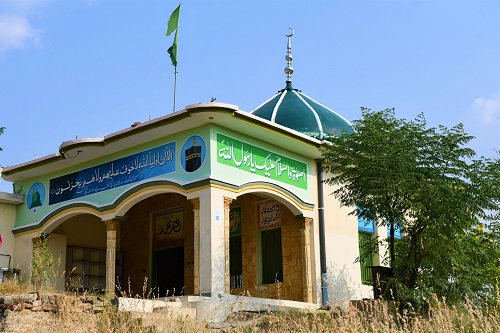
Today, the local community visits the shrines on a number of occasions to seek the blessing of the female saint of Budhial. The tomb of Bibi Rabia contains six graves. The prominent grave belongs to Bibi Rabia and her two sons Mian Muhammad Hast and Mian Mang Ladha who were known for their piety. Two other graves belong to Mian Muhammad Aulia son of Mian Muhammad Hast and Mian Muhammad Ghuas son of Mian Muhammad Hast. The descendants of Mian Muhammad Hast are known as Hastal. The sixth grave belongs to a child. The grave of Mian Sultan Muhammad, the husband of Bibi Rabia, is located east of the tomb of Bibi Rabia. The graveyard of Bibi Rabia also contains some stone carved graves which are noted for their beautiful floral and geometric designs.
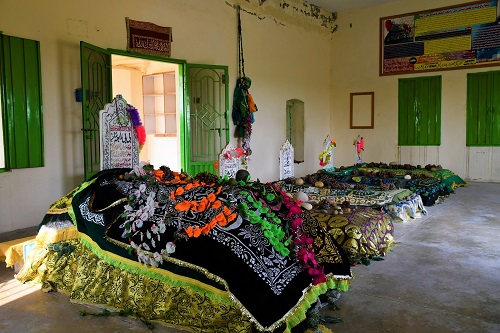
Apart from the graves of mystics, Budhial village also hosts three historical mosques. The earliest mosque in the village is called Wadi Masjid or Jamia Masjid, which was built when the grandsons of Budha Khan founded Budhial village. It was a small stone-built mosque that was later expanded. The Jamia mosque was noted for beautiful stone and wood carvings. Its wooden door was removed during a renovation two decades ago. The stone carved façade of the mosque was also removed. Only the western wall retains the original stonework.
The second historical mosque in Budhial was also stone-built structure. This mosque is locally known as Veerey Wali Masjid, as it was built by Baba Veeru (Waris), and was located near his house. The mosque has lost its originality due to frequent renovations. Only the western wall retains some original aspects, but it is also whitewashed. The third oldest mosque of the village is Ubarni Pand Wali Masjid, which was built by the nobles of the Jodhial tribe. Malik Muhammad Ghaus, the author of Tarikh-e-Budhial believes that the mosque was built in the fourth quarter of the 18th century.
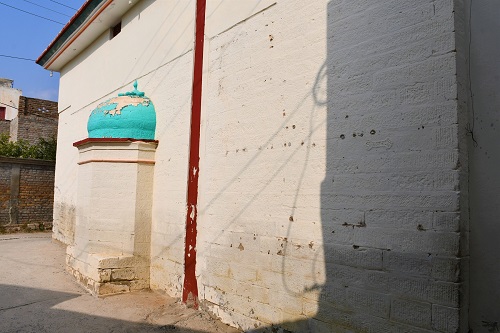
Apart from the nobles of the Jodhials, the people of Pharwal, Jagial, Parhal, and Mastial lineages financially contributed to its construction. Like the Jamia mosque, Ubrani Pand Wali Masjid or Ustad Ghafoor Wali Masjid and Veerey wali Masjid, there were many stone-built mosques in nearby villages which also underwent renovations and lost their originality. The distinctive features of the mosques of Budhial village were their stonework, woodwork and paintings.
_________________
 Dr. Zulfiqar Ali Kalhoro is an anthropologist and has authored 12 books: ‘Symbols in Stone: The Rock Art of Sindh’, ‘Perspectives on the art and architecture of Sindh’, ‘Memorial Stones: Tharparkar’ and ‘Archaeology, Religion and Art in Sindh’. He may be contacted at: zulfi04@hotmail.com
Dr. Zulfiqar Ali Kalhoro is an anthropologist and has authored 12 books: ‘Symbols in Stone: The Rock Art of Sindh’, ‘Perspectives on the art and architecture of Sindh’, ‘Memorial Stones: Tharparkar’ and ‘Archaeology, Religion and Art in Sindh’. He may be contacted at: zulfi04@hotmail.com
Courtesy: The Friday Times Naya Daur Lahore